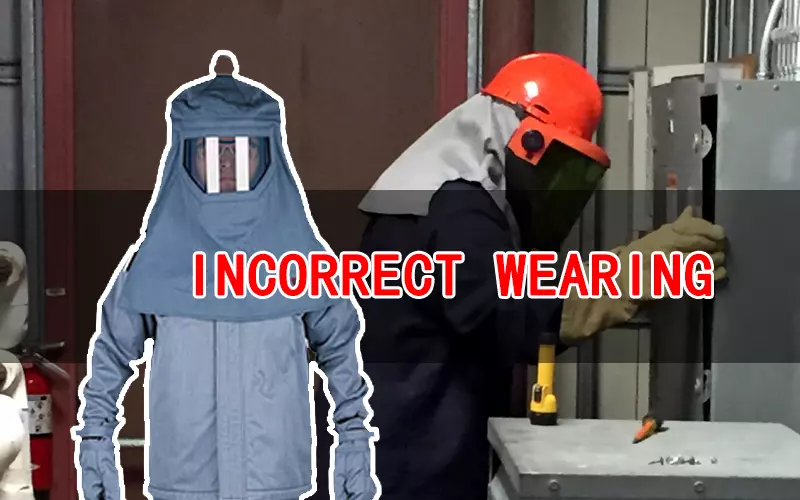Shanghai, China
+86-17317656853
inquiry@cgprotection.com



— A Small Mistake Can Lead to Irreversible Injuries
In high-risk industries such as power transmission, energy storage, photovoltaics, chemical processing, and metallurgy, arc flash accidents remain one of the most severe threats to worker safety. Arc flash PPE is the final line of defense. However, many injuries do not result from equipment failure, but from incorrect wearing practices—small deviations that can instantly invalidate the protection.
This article analyzes why improper use of arc flash clothing is so dangerous, the consequences it may trigger during an accident, and how to avoid these risks.
Arc temperatures can reach 19,000°C, hotter than the surface of the sun.
Intense energy can be released in milliseconds.
Pressure waves can cause hearing damage or knock workers off their feet.
Vaporized metal and molten fragments can result in deep burns.
In such extreme conditions, any error in wearing PPE will be drastically magnified.
Common errors include:
Leaving collars, zippers, or buttons partially open
Loose or unfastened cuffs
Regular clothing exposed at openings
Hem not fully covering the waistband
During an arc event, these exposed areas receive direct heat impact, causing second- or third-degree burns in milliseconds.
A single unfastened collar can result in severe burns to the neck.
When arc flash clothing is too loose or improperly secured:
Hot gases and molten metal can enter through gaps
Heat rapidly rises inside the garment
Internal burns may exceed the severity of external exposure
Research shows that about 20% of arc flash burn injuries result from hot gases entering the clothing, not external heat alone.
Common mistakes:
Wearing polyester/nylon under the arc flash suit
Clothing with plastic logos or prints
Using layers that do not meet protection requirements
Synthetic fibers melt instantly under heat, adhering to the skin and causing extremely painful, difficult-to-treat injuries.
Over 50% of severe injuries stem from incorrect inner layers.
The ATPV/EBT rating relies on correct layering.
Reducing or replacing layers can decrease protection by 30%–60%.
Meaning:
A suit originally rated for 8 cal/cm² may effectively drop to 4 cal/cm² when worn incorrectly.
Examples include:
Metal belts, metal zippers
No arc-rated gloves
Wearing regular sneakers or synthetic socks
Skipping arc-rated hood or face shield
Metal pieces can become superheated injury points, and hands/feet/face often become the most vulnerable areas.
Arc pressure enters through the opening, causing extensive chest burns and internal charring.
Inner clothing melts and bonds to the skin, requiring surgical removal with damaged tissue. Recovery may take more than a year.
Results in corneal burns and severe facial injuries, even if the rest of the body was protected.
The common theme:
The garment did not fail—the wearing method did.
Zippers, buttons, cuffs, hems—all must be fully secured.
Use cotton or arc-rated undergarments.
Too loose → chimney effect
Too tight → restricted movement and garment stress failure
Head, face, hands, and feet must all be protected.
Any missing piece becomes a critical weak point.
Arc rating must be equal to or greater than the incident energy.
Arc flash PPE is a life-saving barrier, but it only works if worn properly.
Studies confirm that:
Over 70% of arc flash injuries can be prevented through correct PPE use.
A moment of negligence can cause permanent injury. This is a safety issue that every worker and organization must take seriously.
Tags:
Shanghai C&G's personal protective clothing and PPE products are trusted by customers in the world. Our products are exported worldwide, with a strong presence in the United States, China, Japan, Germany, the United Kingdom, India, France, Italy, Brazil, and Canada. In addition, we have a significant customer base in other countries across each continent, including Australia, New Zealand, South Africa, Nigeria, and Egypt in Africa; Argentina, Chile, and Mexico in South America; Russia, South Korea, and Indonesia in Asia; Spain, Poland, and Turkey in Europe; and Saudi Arabia and the United Arab Emirates in the Middle East. Wherever you are in the world, we have the products you need to stay safe and protected. Contact us today to learn more about our products and how we can help you meet your safety needs.










© 2023 Shanghai C&G. All Rights Reserved.